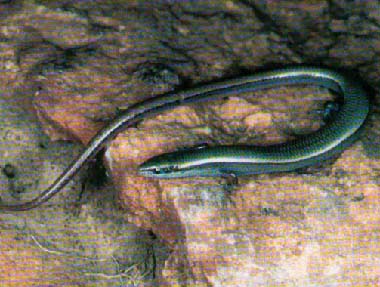Chernov's snake-eyed skink: Red Data Book of Armenia

Skinks — Scincidae
Status. An endangered species of low numbers and limited distribution. Listed in the Red Data Book of the former USSR. Listed in the IUCN Red List of Threatened Species (ver. 3.1) as Least Concern. According to IUCN criteria categorized as Critically Endangered CR A2ac; B2ab(ii,iii).
Distribution. In Northern Eurasia occurs only in Central Armenia, Turkey (Southern and Central Anatolia) and Northern Syria.
Distribution in Armenia. Lives only in the middle Hrazdan riverside. Scattered populations are known from the vicinities of the Karashamb, Bjni and Teghenik villages. The total coverage of populations is 3–4 km2.
Habitats. Inhabits steep stony slopes covered with arid grasslands dominated by forbs and cereals. Occurs also in rocky outcrops and fractures almost deprived of vegetation. Most of its time spends underneath the stones.
Biological traits. Comes outwards after hibernation in late March. In hot dry months conceals in deep hideouts and appears on the surface only in September. Feeds on small hymenopterans, ants, flies, beetles and spiders.
Population size and its trends. The total population size is 250–300 individuals. In the spring of 1985, 1–2 skinks were uncovered over a hectare by overturning the stones. Recently, skink habitats were affected by intense human pressure and numerous surveys turned out to be fruitless. At present, some skink sites are totally deteriorated or encroached.
Major threats. Habitat encroachment and construction works associated with expansion of the Karashamb, Arzakan, Teghenik and Bjni villages. Agricultural activities in local mountain grasslands deteriorate the skink habitats around the villages and underlie the plight of the population.
Conservation measures. Not protected. It is essential to set aside the skink habitats as sanctuaries.
Suggestions
 The Ministry of Environment sent a letter international partners to draw their attention to the real danger of environmental disasters as a result of Azerbaijan's large-scale aggression towards the territory of Armenia
The Ministry of Environment sent a letter international partners to draw their attention to the real danger of environmental disasters as a result of Azerbaijan's large-scale aggression towards the territory of Armenia
 Vicia pisiformis: Red Data Book of Armenia
Vicia pisiformis: Red Data Book of Armenia
 Vavilovia formosa: Red Data Book of Armenia
Vavilovia formosa: Red Data Book of Armenia
 Trigonella capitata: Red Data Book of Armenia
Trigonella capitata: Red Data Book of Armenia
 Trigonella astroides: Red Data Book of Armenia
Trigonella astroides: Red Data Book of Armenia












